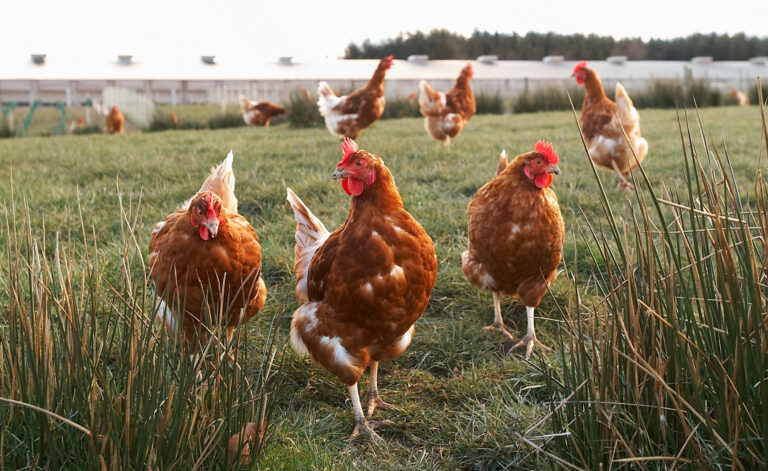Following changes to the Red Tractor standards on poultry relating to windows and enrichment, the scheme has put together a list of FAQs for farmers in the chicken scheme.
Please direct any queries to memberhelp@redtractor.org.uk
Enrichment
| From 1 October 2018 the standard for broilers and poussin will be as follows: | ||
|---|---|---|
| AH.d.1 Environmental enrichment must be provided from day 7 at the latest |
Broilers and poussin | Environmental enrichment is evenly spaced throughout the house and consists of all of the following:
Where reusable, environmental enrichment is capable of being cleaned and disinfected |
| From the 1 October 2018 the standard for free range will be as follows: | ||
|---|---|---|
| AH.d.1 Environmental enrichment must be provided from day 1 |
Free Range | Environmental enrichment is evenly spaced throughout the house and consists of all of the following:
Where reusable, environmental enrichment is capable of being cleaned and disinfected |
They must be no smaller than a standard half size bale.
What is the minimum size requirement for boxes?
The same as for bales; they must be no smaller than a standard half size bale.
At what point in its deterioration during the crop would a bale need replacing – does the bale need to remain intact for the whole crop?
The bales do not need to remain intact for the whole crop and usually would not need replacing. Assessors will be looking for evidence that bales were made available at the beginning of the crop e.g. part bales, small piles of shavings or straw, at the end of the crop. If any bales are left intact at the end of the crop they must not be saved for future crops. They must be discarded with the rest of the litter when the shed is cleaned out.
If bales are wrapped, at what point during the crop can they be cut open to allow birds to break them down?
Bales can be cut open at any time. If birds are struggling to break into the bales themselves then it is advised that slits are made in the wrapping as birds should have access to the material inside the bale.
How should the plastic bale wrap be dealt with if it becomes distributed through the bedding?
Bale wrapping should be removed as bales are destroyed. This can occur during routine flock inspections.
How long before catching can enrichment be removed?
Perches and boxes can be removed up to 48 hours before catching. Bales should not need to be removed as they should have broken down enough to not cause an issue.
If the catch was a thin, how soon after the catch must enrichment be replaced?
Replace immediately to ensure the correct level of enrichment for the number of birds in the shed.
Perch design:
The objective of perches is to provide a means whereby the birds can elevate themselves above the floor. There are a number of different perch designs e.g. rails, slats, A-frames, logs, platforms.
For those perches which are linear in design (e.g. rails, A-frames) the requirement is for 2 linear metres per 1000 birds. There is no requirements for the length of each individual perch and they do not need to be continuous.
For platform style perches surface area is more important than length. The requirement is 0.3m2 of platform per 1000 birds. The design of the platform must allow the bird to grip.
Pecking objects
Pecking objects must be clean and pose no risk to the bird. The following is a list of examples that could be used: • Cable ties • Chains • String • Bottles • Balls • Brassicas/ corn cobs
Unwrapped straw bales do not count as pecking objects. CDs are not recommended as they can shatter easily.
Windows
From the 1 October 2020 the standard for broilers, poussin and free range will be as follows:
| Standard | What | How you will be measured |
|---|---|---|
| HF.e.2 Windows must be fitted in all buildings which house birds |
Broilers and poussin
Free range |
|
Yes, but you have until 1 Oct 2023 to do this. This ensures that all Red Tractor broilers, poussin and free range chickens have access to natural light from Oct 2020 but allows extra time for those who already have 1% windows to upgrade to 3%.
Can windows be opaque/ frosted?
Yes, as long as they let natural light through.
What materials are acceptable for windows?
Glass and polycarbonate are both acceptable. Windows must be double glazed. If using glass it must be toughened on the inside. If using polycarbonate it is important not to allow a build-up of dust or insects between the sheets – this can occur where the sheets have not been sealed together.
Can the windows be in the roof?
Yes, windows can be in the roof but these may require a higher level of management on warmer days.
What constitutes ‘evenly distributed’ windows?
The object of the windows being evenly distributed is to ensure an even spread of light throughout the house. It can be harder to manage the use of windows where light is not evenly distributed. Windows may be just down one side of the house or they may miss out panels evenly throughout the shed due to the presence of fans etc…. Ultimately, assessors will be looking for as even a spread of light as possible.
Are pop-holes considered windows?
Yes, pop holes allow natural light in and therefore count towards the requirement for windows.


